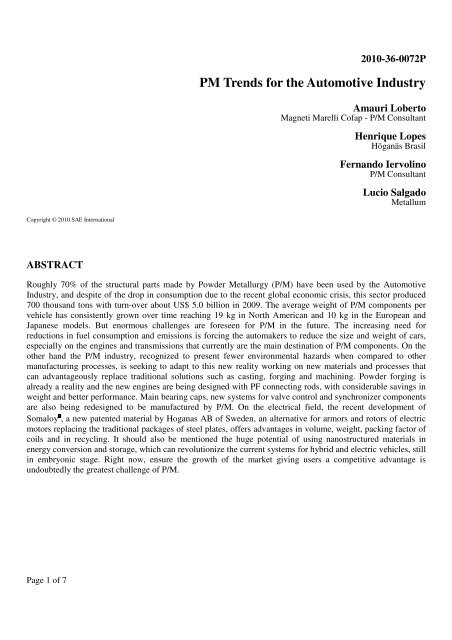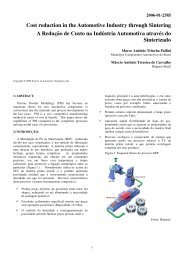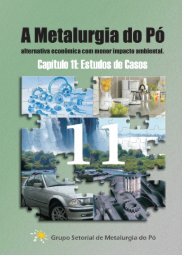PM Trends for the Automotive Industry
PM Trends for the Automotive Industry
PM Trends for the Automotive Industry
Create successful ePaper yourself
Turn your PDF publications into a flip-book with our unique Google optimized e-Paper software.
Copyright © 2010 SAE International<br />
ABSTRACT<br />
Page 1 of 7<br />
2010-36-0072P<br />
<strong>PM</strong> <strong>Trends</strong> <strong>for</strong> <strong>the</strong> <strong>Automotive</strong> <strong>Industry</strong><br />
Amauri Loberto<br />
Magneti Marelli Cofap - P/M Consultant<br />
Henrique Lopes<br />
Höganäs Brasil<br />
Fernando Iervolino<br />
P/M Consultant<br />
Lucio Salgado<br />
Metallum<br />
Roughly 70% of <strong>the</strong> structural parts made by Powder Metallurgy (P/M) have been used by <strong>the</strong> <strong>Automotive</strong><br />
<strong>Industry</strong>, and despite of <strong>the</strong> drop in consumption due to <strong>the</strong> recent global economic crisis, this sector produced<br />
700 thousand tons with turn-over about US$ 5.0 billion in 2009. The average weight of P/M components per<br />
vehicle has consistently grown over time reaching 19 kg in North American and 10 kg in <strong>the</strong> European and<br />
Japanese models. But enormous challenges are <strong>for</strong>eseen <strong>for</strong> P/M in <strong>the</strong> future. The increasing need <strong>for</strong><br />
reductions in fuel consumption and emissions is <strong>for</strong>cing <strong>the</strong> automakers to reduce <strong>the</strong> size and weight of cars,<br />
especially on <strong>the</strong> engines and transmissions that currently are <strong>the</strong> main destination of P/M components. On <strong>the</strong><br />
o<strong>the</strong>r hand <strong>the</strong> P/M industry, recognized to present fewer environmental hazards when compared to o<strong>the</strong>r<br />
manufacturing processes, is seeking to adapt to this new reality working on new materials and processes that<br />
can advantageously replace traditional solutions such as casting, <strong>for</strong>ging and machining. Powder <strong>for</strong>ging is<br />
already a reality and <strong>the</strong> new engines are being designed with PF connecting rods, with considerable savings in<br />
weight and better per<strong>for</strong>mance. Main bearing caps, new systems <strong>for</strong> valve control and synchronizer components<br />
are also being redesigned to be manufactured by P/M. On <strong>the</strong> electrical field, <strong>the</strong> recent development of<br />
Somaloy , a new patented material by Hoganas AB of Sweden, an alternative <strong>for</strong> armors and rotors of electric<br />
motors replacing <strong>the</strong> traditional packages of steel plates, offers advantages in volume, weight, packing factor of<br />
coils and in recycling. It should also be mentioned <strong>the</strong> huge potential of using nanostructured materials in<br />
energy conversion and storage, which can revolutionize <strong>the</strong> current systems <strong>for</strong> hybrid and electric vehicles, still<br />
in embryonic stage. Right now, ensure <strong>the</strong> growth of <strong>the</strong> market giving users a competitive advantage is<br />
undoubtedly <strong>the</strong> greatest challenge of P/M.
1. INTRODUCTION<br />
<strong>Automotive</strong> industry is <strong>the</strong> main driving <strong>for</strong>ce <strong>for</strong> <strong>the</strong> P/M global development. Figure 1 shows <strong>the</strong> P/M market<br />
share, indicating that almost 70% of application is used <strong>for</strong> vehicles production. Unlike <strong>the</strong> stability or even<br />
shrinkage of <strong>the</strong> automotive market of developed countries in 2009, <strong>the</strong> production of vehicles in developing<br />
countries has shown strong and consistent growth. China has become <strong>the</strong> world's leader producer and analysts<br />
believe that Brazil will overtake Germany as <strong>the</strong> fourth largest market in a near future.<br />
Page 2 of 7<br />
Figure 1 - P/M market share<br />
On <strong>the</strong> o<strong>the</strong>r hand a reduction of P/M kilograms per car was noticed in <strong>the</strong> USA. Few years ago <strong>the</strong> average was<br />
22Kg but now this weight is around 18~19Kg according to Michael E. Lu<strong>the</strong>ran, MPIF president, during <strong>the</strong><br />
last PowderMet 2010 in <strong>the</strong> USA. The main reason <strong>for</strong> this change is undoubtedly <strong>the</strong> pressure <strong>for</strong> reducing fuel<br />
consumption and emissions, which are <strong>for</strong>cing <strong>the</strong> automakers to reduce <strong>the</strong> size and weight of cars, especially<br />
on <strong>the</strong> engines and transmissions <strong>for</strong> which most of P/M components are designed. Figure 2 shows <strong>the</strong>se figures<br />
in terms of average consumption of sintered products per car.<br />
Figure 2 - Average weight of P/M components per vehicle<br />
MPIF, E<strong>PM</strong>A, J<strong>PM</strong>A
Despite <strong>the</strong> projected drop of P/M usage per car in USA, recent in<strong>for</strong>mation shows that <strong>the</strong> American<br />
automotive market is reacting and <strong>the</strong> introduction of new systems is pushing again <strong>the</strong> P/M industry. Mr.<br />
Lu<strong>the</strong>ran in<strong>for</strong>med during <strong>the</strong> PowderMet 2010 that <strong>the</strong> launching of new six-speed transmissions by GM and<br />
Ford have high P/M content, in <strong>the</strong> range of 13 kilos.<br />
Ano<strong>the</strong>r factor that contributes to <strong>the</strong> increasing use of P/M parts is its low environmental impact when<br />
compared with o<strong>the</strong>r processes such as <strong>for</strong>ging, casting or machining. Companies have increasingly sought<br />
solutions that contribute to reducing energy consumption throughout <strong>the</strong> production chain as well as reducing<br />
<strong>the</strong> consumption of raw material. Powder metallurgy provides <strong>the</strong>se benefits as shown in figure 3.<br />
Page 3 of 7<br />
Figure 3 – Energy consumption and raw material usage<br />
Moreover, P/M mechanical properties and dimensional tolerances can match or even exceed those of materials<br />
obtained by o<strong>the</strong>r processes, as shown in figure 4. To reach <strong>the</strong> desired results, it is very important a co-design<br />
work between <strong>the</strong> customer and <strong>the</strong> P/M manufacturer.<br />
Figure 4 – P/M properties can match or exceed o<strong>the</strong>r processes
2. POTENTIAL MARKET FOR P/M IN SOUTH AMERICA<br />
In 2008, 22.300 tons of sintered parts were sold in South America, 16.000 ton of <strong>the</strong>m to <strong>the</strong> automotive<br />
industry. The <strong>for</strong>ecast <strong>for</strong> <strong>the</strong> production of light vehicle and motorcycles in South America <strong>for</strong> <strong>the</strong> next years<br />
are very promising as shown in Figure 5. It is expected an annual growth rate of 6.1% <strong>for</strong> cars and 7.3% <strong>for</strong><br />
motorcycles in <strong>the</strong> period, and such predictions are supported by important recent changes in <strong>the</strong> economy of<br />
<strong>the</strong> region [1]. In <strong>the</strong> last ten years, at least 20 million Brazilians have joined <strong>the</strong> middle class. From Argentina<br />
is also expected a vigorous growth of <strong>the</strong> automotive market <strong>for</strong> <strong>the</strong> near future.<br />
Figure 5 - Light vehicles and motorcycles production<br />
HIS Global Insight, Forecast 2010 - 2014, June 2010<br />
For <strong>the</strong> P/M industry <strong>the</strong> growth can be even higher. Today, <strong>the</strong> South America's models use an average of 5.5<br />
kg of P/M products per car, and this figure can easily reach 7.9 kg considering <strong>the</strong> conversion of components<br />
still manufactured by processes o<strong>the</strong>r than P/M. For engines, parts that could be converted in <strong>the</strong> near future, as<br />
<strong>the</strong>y are already used extensively by USA, Europe and Japan automakers are: main bearing caps, connecting<br />
rods, camshaft lobes and components <strong>for</strong> variable camshaft. Synchronizer hubs and rings, shift <strong>for</strong>ks and clutch<br />
hubs <strong>for</strong> transmissions also represents an excellent potential <strong>for</strong> P/M in South America. Figure 6 shows<br />
examples of <strong>the</strong>se components.<br />
Figure 6 - Potential use of P/M in South America's models<br />
Also contribute <strong>for</strong> <strong>the</strong> P/M industry growth, <strong>the</strong> demand <strong>for</strong> com<strong>for</strong>t items like air conditioning, assisted<br />
steering, automatic transmission or automated gearbox that are becoming more frequent. New safety regulations<br />
will make compulsory <strong>the</strong> use of features like air-bags and anti-lock braking systems in <strong>the</strong> next four years.<br />
Page 4 of 7
3. TRENDS IN THE AUTOMOTIVE INDUSTRY<br />
The main challenge <strong>for</strong> <strong>the</strong> automotive industry in <strong>the</strong> next few years will be to improve <strong>the</strong> efficiency of <strong>the</strong><br />
internal combustion engines in order to lower <strong>the</strong> fuel consumption with a minimum impact to <strong>the</strong> environment.<br />
Ano<strong>the</strong>r important challenge is increasing <strong>the</strong> active and passive safety <strong>for</strong> passengers and pedestrians. These<br />
new demands will require from <strong>the</strong> South American automakers <strong>the</strong> introduction of new control systems already<br />
used abroad, such as variable cam timing, variable valve timing and lift, direct fuel injection, electrically<br />
assisted steering systems and more efficient braking systems. With this perspective, <strong>the</strong> development of new<br />
components should include <strong>the</strong> use of lighter and better per<strong>for</strong>mance materials.<br />
In fact <strong>the</strong> automotive industry is going to pass through a transition where internal combustion engines will not<br />
be completely substituted. Most of <strong>the</strong> green vehicles will be hybrid solutions where an internal combustion<br />
engine is combined with an electric motor. According to McKinsey Global Institute, is expected that <strong>the</strong> electric<br />
vehicles and hybrid electric vehicles to surge by 18 – 20% per year from 2009 – 2012 and will account <strong>for</strong> an<br />
estimated 10% of all auto sales by 2015 [2].<br />
4. CHALLENGES AND OPPORTUNITIES FOR THE P/M INDUSTRY<br />
P/M is a versatile technology that can greatly contribute to <strong>the</strong> automotive industry in this new path. Valve<br />
metallization and high speed steel valve seats [3] are being used in flex-fuel engines with high compression rate.<br />
Ef<strong>for</strong>ts in order to get higher material densities with techniques as warm compaction, die wall lubrication, high<br />
compressibility powders and selective densification allows <strong>the</strong> production of high per<strong>for</strong>mance components<br />
such as transmission gears, synchronizer sleeves and rings, shift <strong>for</strong>ks and clutch hubs. The surface<br />
densification technique is also a reality and several transmission gears are already under regular mass<br />
production. Single pressing and sintering connecting rods will lower P/M manufacturing costs opening excellent<br />
opportunities <strong>for</strong> this industry.<br />
Electric vehicles have a potential of several kilograms in its traction motor system as well as o<strong>the</strong>rs systems,<br />
and thanks to recent developments of new materials, <strong>the</strong> P/M industry can follow <strong>the</strong> market trends <strong>for</strong> electric<br />
and hybrid vehicles. Soft Magnetic Composites (SMC) is a special class of materials based on fine iron powder<br />
particles coated with a nanolayer of electrically insulating material. This powder can be compacted, using <strong>the</strong><br />
traditional <strong>PM</strong> method, into a solid component structure with <strong>the</strong> ability to carry flux in 3D and present low<br />
conductivity in all directions. All <strong>the</strong>se properties allow <strong>the</strong> SMC usage in a sort of new motor topologies and<br />
open <strong>the</strong> opportunity to new applications. Some of <strong>the</strong>se applications are common rail diesel injector, ABS<br />
pump motor, electric power steering torque sensor and many o<strong>the</strong>rs under development. There is no doubt that a<br />
good target <strong>for</strong> SMC materials are high per<strong>for</strong>mance traction motors on electric vehicles, with reduced iron<br />
mass, high efficiency and increased torque density [4]. The use of SMC <strong>for</strong> <strong>the</strong> electric motors can demand<br />
more than 15 kilos of P/M per vehicle.<br />
It must be mentioned that P/M offer important environmental advantages when compared to competing<br />
processes: lower energy consumption and more efficient use of raw materials. Also <strong>the</strong> possibility to obtain net<br />
shape or near net shape parts reduce <strong>the</strong> use of cutting oil on final machining operation. Life cycle assessment<br />
analysis [5] proved that P/M is a manufacturing process with less environmental impact.<br />
Metal Injection Molding (MIM) can play an interesting role in <strong>the</strong> automotive industry due to <strong>the</strong> net-shape<br />
capability <strong>for</strong> complex shape parts which can reduce machining costs to low levels. Larger and more precise<br />
parts are being developed and short production runs can be cost effective. Parts as ignition lock and turn signal<br />
lever [9] are already in normal production. Vanes <strong>for</strong> compressors can be a feasible alternative <strong>for</strong> <strong>for</strong>ged and<br />
machined parts and can be potentially exploited.<br />
Page 5 of 7
P/M light alloys can offer substantial weight savings, contributing to improved efficiency of <strong>the</strong> vehicles. Parts<br />
such as oil pump rotors and housings, and camshafts bearing caps are already in normal production. Aluminum<br />
and titanium alloys must be considered as promising materials also <strong>for</strong> connecting rods, valve train and o<strong>the</strong>r<br />
power train components.<br />
Aluminum foams are an interesting alternative <strong>for</strong> vehicles weight saving with <strong>the</strong> advantage to be a stiff and<br />
also a high impact energy and absorption material. O<strong>the</strong>r properties are vibration reduction, sound absorption,<br />
low <strong>the</strong>rmal conductivity and flame resistance [8]. Sandwiches with aluminum or steel sheets can offer stiffer<br />
materials with a great weight reduction.<br />
Nanoscience and nanotechnology has a huge potential to contribute to <strong>the</strong> development of more efficient<br />
systems <strong>for</strong> storage and conversion of energy required by hybrid and electric cars. Research in <strong>the</strong> use of metal<br />
hydrides <strong>for</strong> hydrogen storage, more efficient batteries and solar cells, development of super capacitors and CO2<br />
carbon capture that can lead to cleaner energy are being extensively done and may contribute to a sustainable<br />
energy system, with better and more effective solutions <strong>for</strong> <strong>the</strong> use of <strong>the</strong> existing finite energy sources [6].<br />
More efficient fuel cells using nanomaterials are each day being investigated and it is difficult to predict when<br />
and how nanoscience and nanotechnology will have <strong>the</strong> largest impact, but <strong>for</strong> sure <strong>the</strong>y will be part of energy<br />
sustainable solutions.<br />
CONCLUSION<br />
The automotive industry is now experiencing a moment of great changes with <strong>the</strong> use of new materials,<br />
processes and technologies in order to produce greener and safer vehicles. P/M is a metal manufacturing<br />
process that can offer net shape or near net shape products with <strong>the</strong> advantage to use fewer raw materials, fewer<br />
trans<strong>for</strong>mation energy and fewer environmental impact compared to o<strong>the</strong>r processes. It is <strong>the</strong> right time to<br />
explore new opportunities through <strong>the</strong> partnership of engineering and research areas of automakers and<br />
supplier. This proactive and cooperative work has to be done from <strong>the</strong> beginning of new developments in order<br />
to achieve <strong>the</strong> best results. It is a responsibility of <strong>the</strong> leaders of <strong>the</strong>se industries to promote and encourage this<br />
revolution.<br />
REFERENCES<br />
[1] HIS Global Insight, Forecast 2010 - 2014, June 2010.<br />
[2] McKinsey& Company, Averting <strong>the</strong> next energy crisis: <strong>the</strong> demand challenge, 2009.<br />
[3] Jesus Filho,E.S.; Jesus E.R.B.; Salgado, L.; Colósio, M.A.; Santos, J.C.; Yoshida, S.; Sartori, C.H.; Rossi,<br />
J.L. Sintered valve seat inserts - microstructural characterisation. Materials Science Forum, v. 530-31, p. 65-70,<br />
2006.<br />
[4] T. J. Woolmer, M.D. McCulloch, Analysis of <strong>the</strong> Yokeless and Segmented Armature machine, Ox<strong>for</strong>d<br />
University, Engineering Department.<br />
[5] K. Edlund, J. Tengzelius, S. Berg, Life Cycle Assessment in <strong>PM</strong>, Powder Metallurgy World Congress and<br />
Exhibition, Granada, Spain, 1998.<br />
[6] Guozhong Cao, Nanostructures & nanomaterials - Syn<strong>the</strong>sis, Properties & Applications, Imperial College<br />
Press, 2004.<br />
Page 6 of 7
[7] M. Zäch, C.Hägglund, D. Chakarov, B. Kasemo, Nanoscience and nanotechnology <strong>for</strong> advanced energy<br />
systems, Elsevier, 2007.<br />
[8] Alulight International GmbH , acessado em 17 de junho de<br />
2010.<br />
[9] ASM Handbook – V7 Powder metal technologies and application, ASM International, p17-18, 2006.<br />
CONTACT INFORMATION<br />
LUCIO SALGADO<br />
METALLUM EVENTOS<br />
E-MAIL: LSALGADO@METALLUM.COM.BR<br />
F. 11 3731-8549<br />
Page 7 of 7




